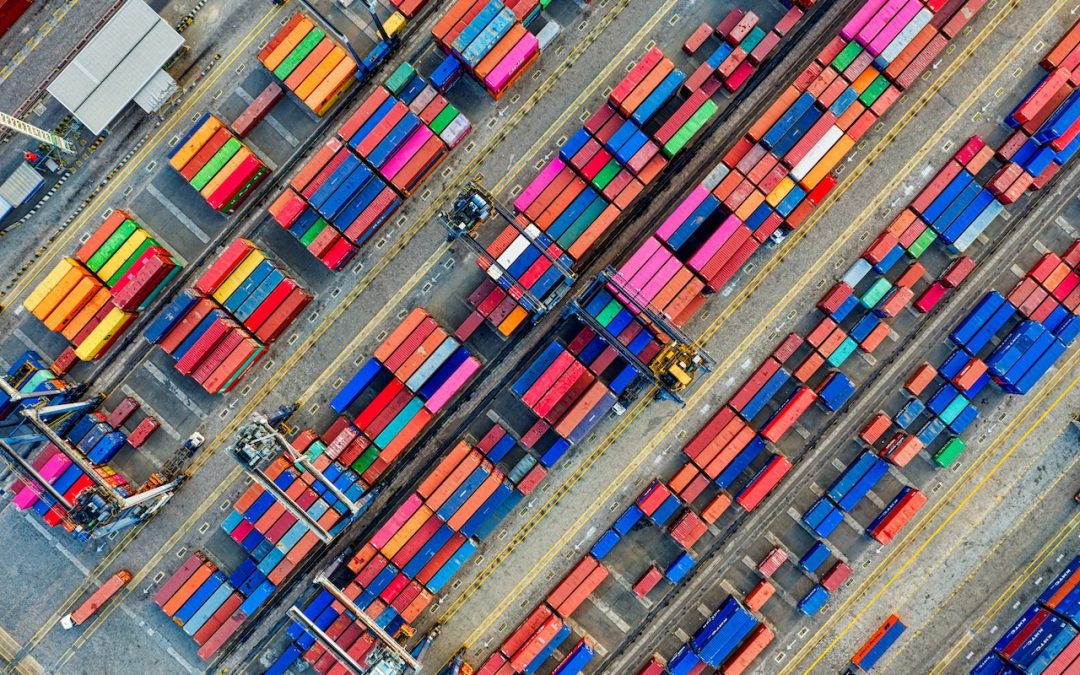ความแออัดของตู้คอนเทนเนอร์ทำให้ระยะเวลารอคอยสินค้าของคุณช้าลงหรือไม่?
นี่เป็นหนึ่งในปัญหาที่ใหญ่ที่สุดที่ทำให้เกิดความล่าช้าในการขนส่งทั่วโลก และมีแนวโน้มสูงที่จะส่งผลต่อความรวดเร็วในการส่งสินค้าของคุณถึงจุดหมายปลายทาง
อ่านต่อไปเพื่อดูว่าเรากำลังพูดถึงอะไร
ความแออัดของตู้คอนเทนเนอร์คืออะไร?
ความแออัดของตู้คอนเทนเนอร์มีความคล้ายคลึงกับการจราจรบนถนนมาก แต่มีขนาดใหญ่กว่ามาก
มันเกิดขึ้นเมื่อเรือจำนวนมากเกินไปจำเป็นต้องเทียบท่าและขนถ่าย (หรือบรรทุก) ที่ท่าเรือที่ไม่สามารถรองรับความจุได้เนื่องจากเต็มแล้ว
เรือขนส่งสามารถมาถึงได้โดยถือตู้คอนเทนเนอร์ 10,000 ถึง 20,000 ตู้ในการขนส่งครั้งเดียว และการขนถ่ายสิ่งเหล่านี้อาจใช้เวลาสูงสุดสามวันทำการ ดังนั้น หากเรือที่บรรทุกตู้คอนเทนเนอร์หรือเรือที่รอการบรรทุกมาถึงท่าเรือที่มีผู้คนพลุกพล่านซึ่งไม่มีท่าเทียบเรือ เรือนั้นจะต้องรอที่จุดจอดเรือจนกว่าจะมีท่าเทียบเรือพร้อมให้บริการ
เมื่อปัญหาความแออัดของท่าเรือ เรือคอนเทนเนอร์จำนวนมากสามารถรอถึงสองสัปดาห์เพื่อเทียบท่าได้
สาเหตุของความแออัด
ความแออัดของท่าเรือเป็นเรื่องที่น่าหงุดหงิดอย่างมากสำหรับทุกคนที่เกี่ยวข้อง และส่งผลโดยตรงต่อห่วงโซ่อุปทานของคุณ ลูกค้าต้องรอสินค้าหลายสัปดาห์ และบริษัทขนส่งต้องจ่ายค่าขนส่งและค่าดำเนินการที่เพิ่มขึ้นเพื่อชดเชยความล่าช้าอันยาวนาน
และในขณะที่การค้าและความต้องการสินค้าทั่วโลกยังคงพุ่งสูงขึ้นอย่างต่อเนื่อง มันก็มีแต่จะแย่ลงเท่านั้น
มาดูสาเหตุบางประการที่มันเกิดขึ้น:
ขาดการแปลงเป็นดิจิทัล
ภาคการเดินเรือไม่เห็นการลงทุนเพียงพอในช่วง 15 ปีที่ผ่านมาเพื่อให้ตรงกับความต้องการที่กำลังเผชิญอยู่ มันต้องฉลาดขึ้นและรวดเร็วขึ้น มีการเรียกร้องให้มีการบูรณาการกลยุทธ์ดิจิทัลมาเป็นเวลานาน และยิ่งสิ้นหวังมากขึ้นเมื่อปัญหาเช่นความแออัดของตู้คอนเทนเนอร์ทำให้ร่างกายอ่อนแอลง
สภาพอากาศ
อุตสาหกรรมการขนส่งต้องเผชิญกับสภาพอากาศที่ไม่เอื้ออำนวยอย่างต่อเนื่อง สิ่งที่ต้องทำคือพายุจะโหมกระหน่ำผิดที่ของโลก และความล่าช้าในการชนอาจเป็นเรื่องใหญ่มาก มากกว่า 3,000 TEU ตกลงสู่มหาสมุทรทุกปีเนื่องจากสภาพอากาศ!
นัดหยุดงาน
พนักงานรถไฟและท่าเรือเป็นหนึ่งในกลุ่มผู้เชี่ยวชาญที่ออกมาประท้วงเรื่องค่าจ้าง งาน และสภาพการทำงาน
ข้อพิพาทขนาดใหญ่ที่ดำเนินอยู่ส่งผลให้คนงานจำนวนมากตกอยู่ในภาวะลำบาก ซึ่งหมายความว่ามีพนักงานที่พร้อมให้ความช่วยเหลือในการแพ็ค ขนถ่าย ตรวจสอบเอกสาร เคลียร์สินค้าผ่านศุลกากร และขนย้ายต่อไปเพื่อเพิ่มพื้นที่ว่างในท่าเรือด้วยซ้ำ
การขาดแคลนไดรเวอร์และอุปกรณ์
หลายประเทศได้รับการนำเข้ามากกว่าการส่งออก และหากสินค้านี้ไม่สามารถเข้าเทียบท่าและขนถ่ายได้อย่างรวดเร็ว ผลกระทบแบบโดมิโนก็จะมีผลบังคับใช้อย่างรวดเร็ว
เมื่อมีรถบรรทุก คนขับ หรือแชสซีไม่เพียงพอ (โครงรถพ่วงที่รถบรรทุกใช้ในการเคลื่อนย้ายตู้คอนเทนเนอร์) สิ่งนี้จะส่งผลโดยตรงต่อความสามารถของท่าเรือในการเคลื่อนย้ายสินค้าได้เร็วเพียงพอ การขาดแคลนคนขับ HGV ซึ่งเกิดจากการแพร่ระบาด ส่งผลให้มีรถบรรทุกไม่เพียงพอที่จะขนย้ายสินค้าออกจากท่าเรือ
ผู้คนกำลังซื้อสินค้ามากขึ้น
ความต้องการสินค้าอยู่ในระดับสูงเป็นประวัติการณ์ สินค้านำเข้าและส่งออกจำนวนมากมีปริมาณมหาศาล และอุตสาหกรรมก็ไม่สามารถรองรับได้เหมือนเมื่อก่อน เมื่อคุณรวมปัญหาด้านความจุเข้ากับสาเหตุที่กล่าวข้างต้น ก็ไม่ยากที่จะเห็นว่าเหตุใดความแออัดของพอร์ตจึงล้นหลาม
ความแออัดของตู้คอนเทนเนอร์มีความหมายต่อสินค้าของคุณอย่างไร
หากพอร์ตได้รับการสำรองข้อมูลหรือไม่มีประสิทธิภาพอย่างมาก จะทำให้เกิดความวุ่นวายในห่วงโซ่อุปทานทั้งหมด ซึ่งส่งผลกระทบต่อผู้จัดส่ง ผู้บริโภค และผู้ค้าปลีก
ความแออัดของตู้คอนเทนเนอร์ไม่เพียงนำไปสู่ความล่าช้าอย่างมากในการรอสำหรับผู้รับสินค้าและผู้บริโภคเท่านั้น แต่ยังสร้างค่าใช้จ่ายเพิ่มเติมสำหรับทุกคนที่เกี่ยวข้องด้วย เนื่องจากเรือที่จอดทอดสมอจะต้องจ่ายค่าบริการท่าเรือและการใช้เชื้อเพลิงที่เพิ่มขึ้น
ดังนั้นความจุที่ลดลงของท่าเรือทั่วโลกจึงส่งผลกระทบต่ออัตราค่าระวางเรือและเวลาขนส่งที่เพิ่มขึ้น
คุณทำอะไรได้บ้าง?
มันเป็นคำถามที่ดี จะ อย่างไร หากคุณเป็นเจ้าของธุรกิจในอุตสาหกรรมการขนส่ง?
(นอกเหนือจากการรอคอยการพัฒนาระบบลอจิสติกส์การขนส่งแบบดิจิทัลที่ชาญฉลาดนั่นเอง)
สิ่งที่ปลอดภัยที่สุดที่คุณสามารถทำได้เพื่อต่อสู้กับปัญหาความแออัดของตู้คอนเทนเนอร์คือการค้นหาบริษัทขนส่งสินค้าที่เชื่อถือได้ซึ่งมีเครือข่ายโลจิสติกส์ขนาดใหญ่ ผู้ส่งสินค้าที่มีชื่อเสียงที่ดีและมีผู้ติดต่อจำนวนมากจะสามารถรับข้อมูลการขนส่งที่สำคัญได้ล่วงหน้าและจัดการกับความล่าช้าอย่างเชี่ยวชาญ เพื่อนำสินค้าของคุณไปยังจุดหมายปลายทางโดยเร็วที่สุด
ไม่แน่ใจว่าคุณกำลังทำงานร่วมกับบริษัทขนส่งสินค้าที่เหมาะสมใช่หรือไม่ กังวลเกี่ยวกับค่าใช้จ่ายเพิ่มเติมเนื่องจากความแออัดของท่าเรือหรือไม่? ติดต่อมิลเลนเนียมวันนี้เพื่อขอคำแนะนำจากผู้เชี่ยวชาญและรับฟังอย่างเป็นมิตร

